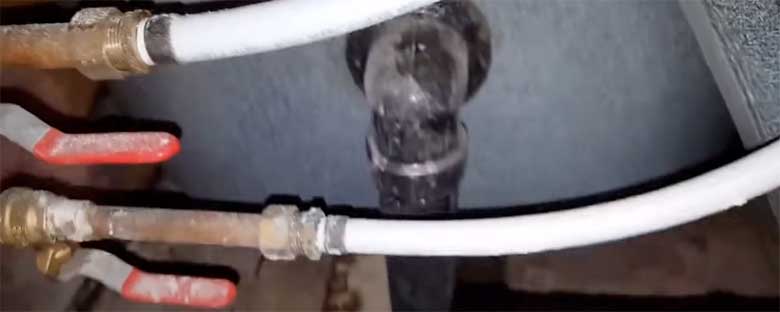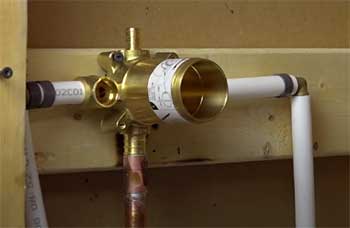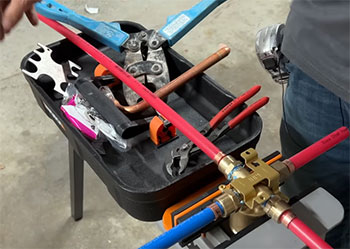Imagine your plumber used PEX for the tub spout drop and you didn’t know. Everyone you know is telling you it is bad, even the strangers on the internet forums.
But why? Why can’t you use PEX for tub spout drop?
Using the wrong material at the wrong place (like PEX for tub sprout drop) can cause tons of issues in the long run. Bouncing off that, here is why you can’t use PEX for your tub spout drop.
Why PEX Isn’t Suitable For Tub Spout Drop

Since we got the basic requirements out of the way, let’s see why you can’t use PEX for your tub spout drop.
- It Is Too Narrow
The tub spout drop should be wide enough to let the water flow. A narrow pipe will block the flow (or bottleneck it). This means your tub will take more time to fill.
The manufacturing companies recommend pipes with more than a ½” inner diameter for tub spout uses. Pipes with lesser diameters can act like bottlenecks and put pressure on the tub spout. The pressure can build up across the system and cause bigger issues.
PEX pipes are too narrow to use for tub spout drop. The inner diameter of the pipe is less than ½”. Therefore, manufacturing companies don’t recommend using PEX for tub spout drop. Sometimes they provide strict instructions to not use PEX for this.
Unless you can find a way of using a bigger PEX pipe for your tub spout drop, the regular ones are not recommended for your tub spout drop use. This leads to the next point.
- Alternate Ways Are Too Complex
The instruction manuals tell you to not use regular ½” PEX pipes because they’re too narrow. What if you can find a bigger pipe? Can you make it work?
If you want to use a bigger ¾” PEX pipe for your tub spout drop, you’ll have to include some extra steps. Tub spouts can’t directly connect to a ¾” pipe. This means you’ll have to find a way of connecting the ½” outlet to your ¾” PEX pipe.
You’ll need to connect your ¾” PEX crimp to a ½” FIP drop-ear style elbow to hold the tub spout. Then you’ll need to work another ¾” PEX crimp to a ½” FIP adapter to where the valve is.
Connect the system with another ¾” PEX between them and you’ll have a working system.
The problem with this alternate mechanism is that it is too complex. You’ll need to work with more parts. It will still be risky because a small error in any part of the process means the entire thing is gone. Or worse, you’ll end up with a dripping tub spout.
- It Isn’t Hard Enough

The pipes you use in your plumbing must be strong. The water running through them will put heavy pressure on the pipes. If they aren’t durable, you’ll end up with a pipe burst.
Copper is a more popular option for tub spout drops because it is durable.
The material is strong, so it holds up nicely against the water pressure. Fitting copper is easier because copper holds its place.
PEX materials are comparatively less sturdy. PEX pipes are too flexible, and it causes problems during fittings too. The pipe won’t hold its place because it is too flexible and shakes a lot.
With a material this shaky, you’re going to end up with a dripping tub spout. If you’re unlucky, the pipe can burst and flood your whole bathroom. It might even block other parts of the plumbing too.
Unless you’re okay with a burst pipe and worrying about it holding u against the water pressure, PEX is not suitable to use for your tub spout drop.
- It Doesn’t Last Long
Plumbing is one of the internal components of your house. You’ll have to go through other layers of materials like your drywall and insulation.
This is why people choose long-lasting plumbing materials. They last long so you’ll have fewer issues to fix.
Tub spouts drop materials like copper take a long time to wear off. It is more resistant to water pressure and other external factors. Copper has a comparatively less corrosion rate and can be used anywhere.
PEX on the other hand is pretty quick to wear off. This is mostly because it does not deal well with water pressure. PEX is more corrosive than copper, so you’ll have to deal with more rust issues.
Your PEX tub spout drop won’t hold out better against external factors either. PEX can burst because of UV exposure and doesn’t do well with heat.
This means you can’t use PEX in places where the sunlight comes in. You can’t use PEX where hot water will come through because it isn’t good with heat.
General Features Of Tub Spout Drop Pipes
You can avoid facing issues later if you pick the right material for your plumbing need when you do it. Different outlets need different settings and materials. Here are the things your tub spout material must have.
Your tub spout drop must have an inside diameter big enough to maintain the water flow and not block it. The tub spout drop needs to be corrosion resistant and sturdy enough to hold its place.
The tub spout drop pipe must be resistant to external factors like UV rays so you can use them anywhere.
Signs It’s Time to Replace a Failing Tub Spout Drop
If your tub spout drop was improperly installed with PEX or another insufficient material, you may eventually experience issues like these:

- Slow or uneven tub filling due to reduced water flow
- Leaking coming from the tub spout or valves
- Visible corrosion, pitting, or mineral deposits on the pipe
- Sagging pipe that is bent or kinked
- Loose tub spout that no longer maintains position
- Dripping or leaking coming from the tub spout itself
These problems indicate it’s time to replace the faulty tub spout drop with a proper rigid pipe material. Catching the issues early on can prevent more severe leaks or flooding. Replace the pipe along with any corroded fittings or valves.
While replacing the tub spout drop is inconvenient, it resolves the problems permanently when done properly. In many cases, the drop pipe can be replaced without the need to remove surround tile or remodel the entire tub area.
Hiring a Plumber for Tub Spout Drop Replacement
Given the importance of a proper tub spout drop, many homeowners choose to hire a professional plumber to take care of replacement. A qualified plumber has the experience to:
- Identify the correct replacement pipe material and size needed.
- Remove the old spout drop safely without damaging existing pipes or valves.
- Install new pipe, fittings, and valves meeting code.
- Ensure the spout drop is properly supported and secured.
- Verify water pressure and test for leaks after installation.
While a DIY savvy homeowner can attempt this project, the risks of damaging your plumbing system are real. The costs associated with a major leak or flood far outweigh the price of hiring a pro. Investing in a professional tub spout drop installation gives peace of mind knowing it was done right.
Frequently Asked Questions (FAQs)
Where should you not use PEX?
PEX should not be used for tub spout drops, exposed hot water lines, or any location in your plumbing system that must withstand high water pressure. PEX is only approved for use in areas with low pressure, like residential water mains and fixture supply lines.
What kind of pipe do you use for a tub spout?
The tub spout drop should be rigid copper, CPVC, or galvanized pipe able to withstand residential water pressure over 100 PSI. Copper is the most common and recommended material. PEX and other flexible tubing is unsuitable for this application.
Is it OK to use PEX for shower valve?
Yes, it is perfectly fine to use PEX for shower valves and the supply lines running to your showerhead, as these operate at normal residential water pressure. PEX can handle up to 80 PSI without issue. Only the tub spout drop itself should not use PEX.
Can you use sharkbite for tub spout?
Sharkbite push-to-connect fittings can be used on the tub spout itself and to connect the spout to the drop pipe. However, sharkbite should not be used for the vertical tub spout drop, which needs to be soldered solid copper pipe. Sharkbite is not rated for the 100+ PSI pressure on a spout drop.
Do rats chew through PEX?
Unfortunately, yes. As we’ve said, PEX materials are flexible and less durable. It is very easy for rodents to chew through this, and most houses with an attic face this problem.
Can I use a ¾” PEX for tub spout drop?
Yes, you can. PEX usually isn’t recommended because of the narrow inner diameter. The regular PEX has a less than ½” diameter, but a ¾” PEX doesn’t have that problem.
If you can get past the extra work, you can definitely use a ¾” PEX for your tub spout drop.
Conclusion
And here is the answer to why can’t you use PEX for tub spout drop.PEX isn’t durable, lasting, or wide enough to be used for your tub spout drop. You can use other materials like copper, brass, or galvanized pipes instead.
Whatever material you’re using, make sure it is compliant with the AHJ and instruction manuals you have. As long as it is durable and wide, you’re good to go.
